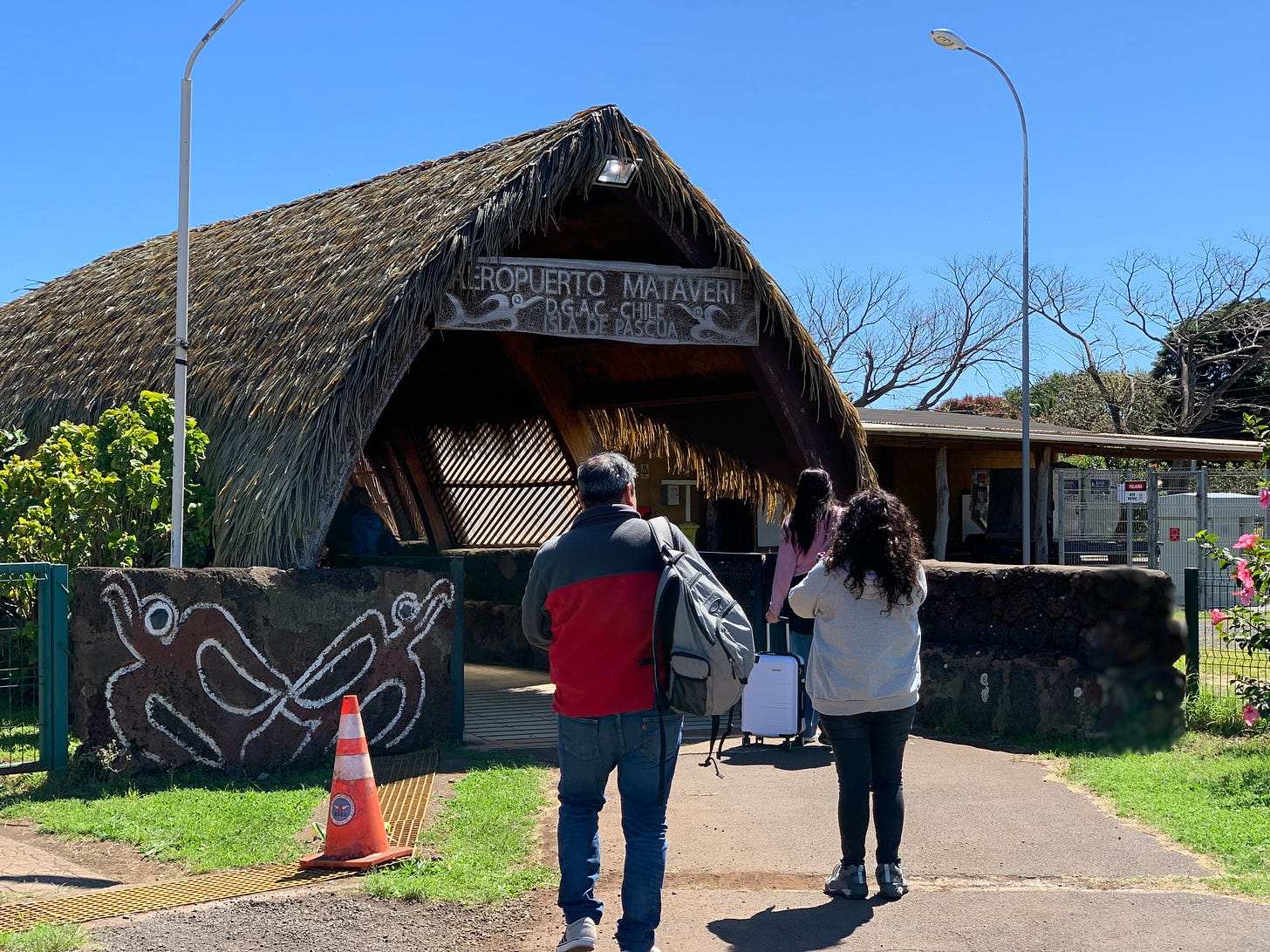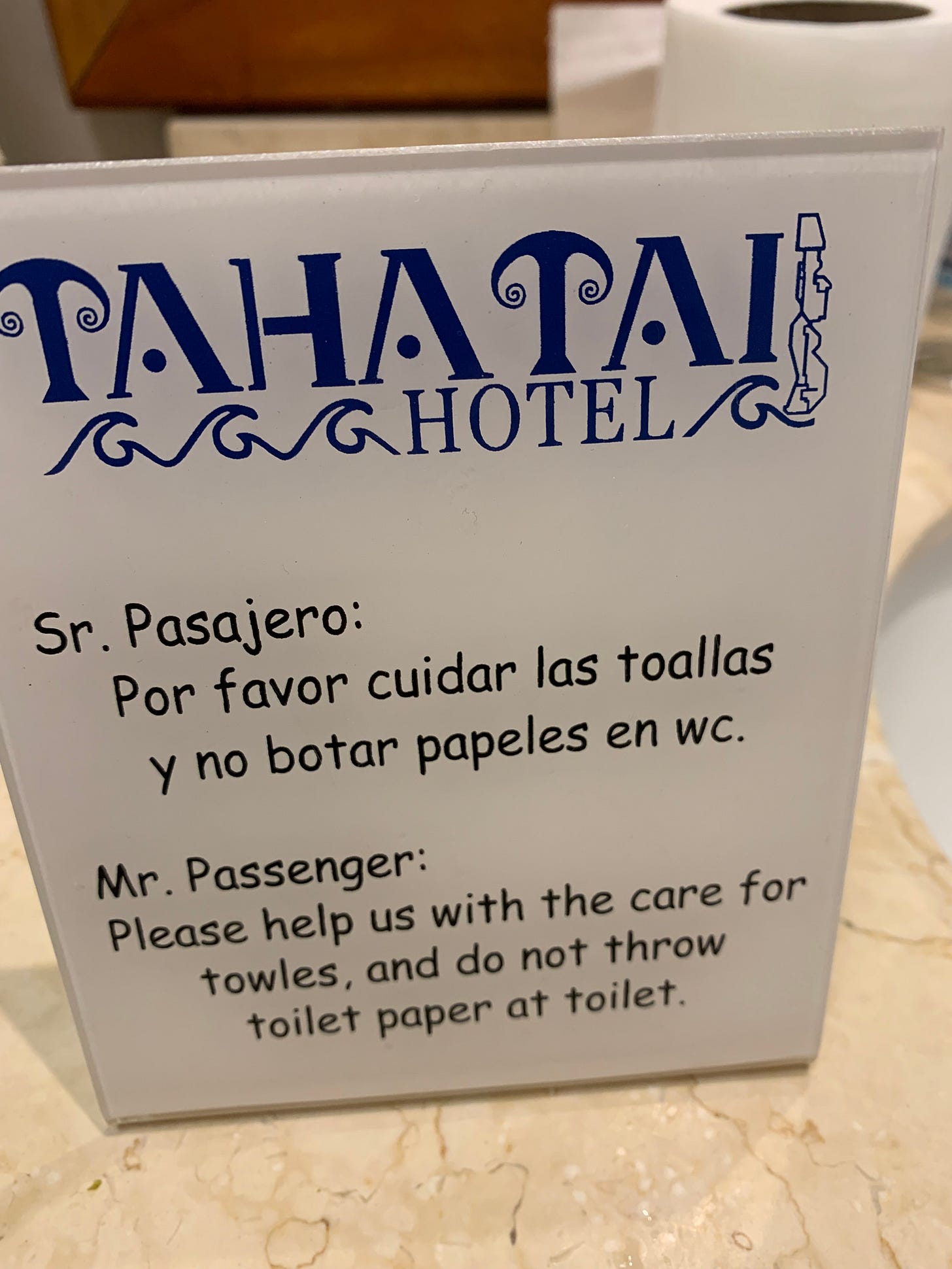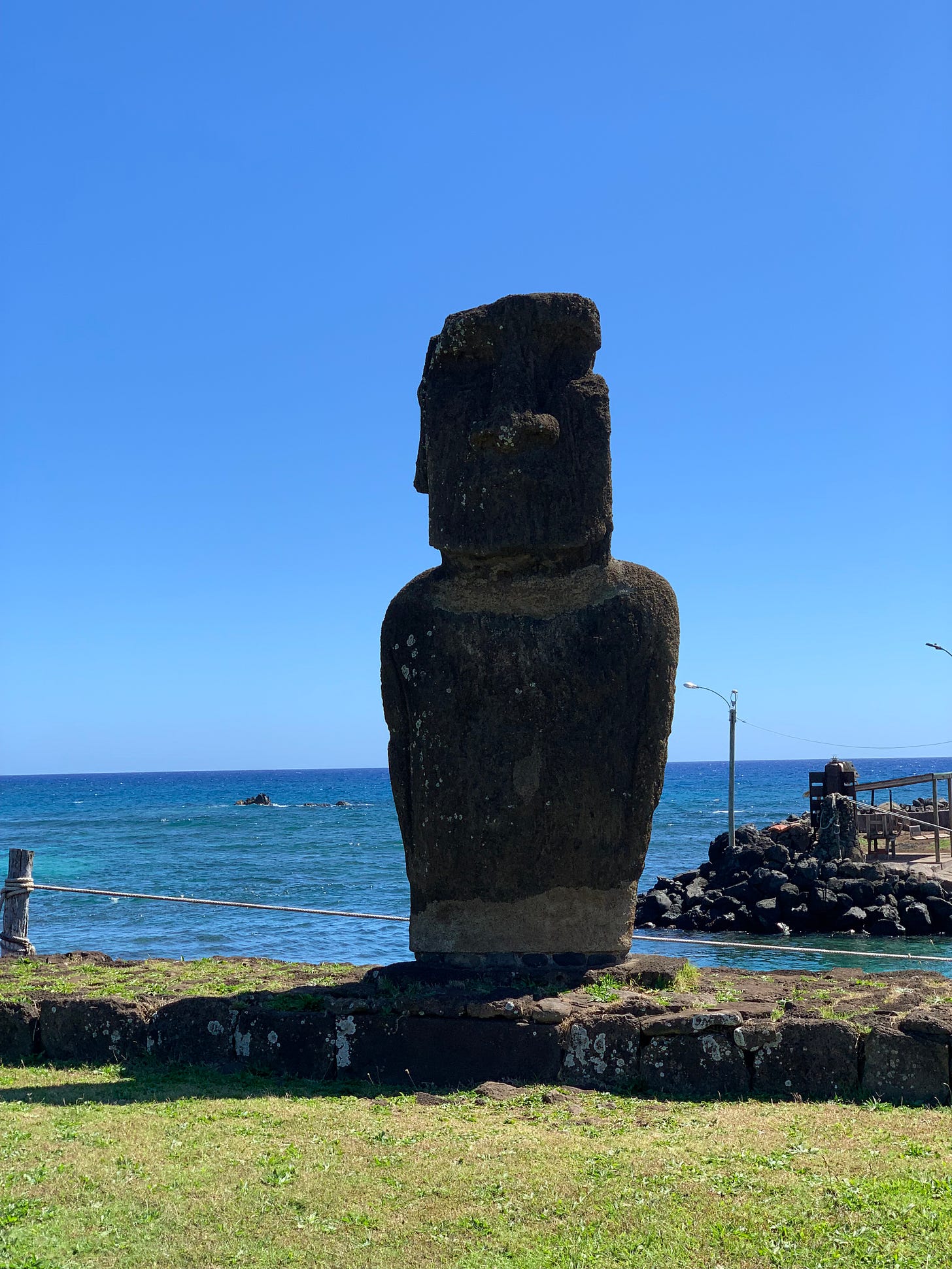Fellow Broad Squader traveler Jane and I have been trying to get to Rapa Nui, aka Easter Island, for three years. First the island shut down for two years due to Covid. Then when flights resumed (the only way you can get here is via a five-hour flight from Santiago), they were limited and sold out many months in advance. On a whim in early August, I checked the LATAM airlines site and praise the Rapa Nui god Make-Make (how literally appropriate is that name?), there were tons of flights. So Jane and I booked a Santiago-Easter Island-Rio de Janeiro vacay for just a month later. We are famous for our lack of advance planning, but this was pushing it even for us. Fortunately everything has been AOK so far.
We spent a night in Santiago before hopping a Dreamliner to Easter Island. The whole island is only 23 km long, which seems necessary to accommodate the bigass runway. The airport has a charming hut entrance that reminds you you’re in Polynesia. Even though Easter Island is part of Chile, it’s proud of its Polynesian roots.
We opted not to take the pricey transfer from the airport offered by the hotel ($45 per person!), figuring we could get a taxi. Which looked problematic for a bit, until one finally pulled up ($5 for the equivalent of maybe half a mile—definitely a good if somewhat nerve-wracking decision). We later ran into our driver, Jeremy, as a server at a local restaurant—I think everyone has multiple jobs here.
We opted for a hotel in the island’s only town, Hanga Roa, because we didn’t plan to rent a car. It seems many people rent cars to tour the sights, but Jane and I decided to use taxis and guides for several reasons: (1): We have the navigational abilities of 4-year-olds, meaning we would for sure get lost even on a small island, (2) the roads are really bad and you can’t rent cars with insurance and (3) we wanted guides to tell us all the pertinent stuff we needed to know about the sights and answer our copious questions that I’m sure weren’t annoying at all : - ).
I recommend our hotel, Taha Tai. It’s in town but also backs up to the beach and it has a pool. The staff is nice and some speak English. Many islanders speak Spanish, Rapa Nui and at least some English. Although the translations can be a tad problematic : - )
We started out by visiting the archaeological museum in Hanga Roa, which was excellent. We learned that the last volcano erupted on Rapa Nui just 3,000 years ago, making it a very young island. About 300 AD, seafarers perhaps from the Marquesa Islands discovered Rapa Nui. Which is shocking considering it’s over 2,000 miles from the nearest land—Chile. The ancient Rapa Nui only had an oral history so we don’t know for sure, but it’s thought that the Polynesian explorers sailed on double canoes for many months to get here. How they knew there was land here is a mystery, although they supposedly navigated by the stars.
There was a guy named Hoto-Matu and his crew in one boat and his sister and crew in another boat, for a total of maybe 100 people. I have never heard the sister’s name despite her being so badass as to command an expedition boat. The brother and sister split up the island (also surprising, although the sister reportedly got the less desirable part). Hoto-Matu became the first king and the island was divided into six clans headed by his sons. No word on whether the sister had descendants and why she apparently didn’t split up her land among them.
Rapa Nui has no native mammals or reptiles—only birds and fish. There are no streams, and the only fresh water comes from an underground spring and rainwater. It frankly doesn’t sound like an ideal spot to settle down, but presumably the new islanders didn’t want to have to travel for 2,000 miles in canoes to go somewhere else. Here’s one of the small cisterns the ancient Rapa Nui people carved to catch rainwater.
About 800 AD, the Rapa Nui were thought to have started carving the moai to commemorate their ancestors. Each moai (there are over 900 on the island) reportedly represents a chief or other bigwig in the clan. They are placed on rock platforms known as ahu and then lesser clansmen are buried in front of them. Here’s one just a few hundred feet from our hotel, smack on the main road and backing up to a fishing port.
The moai are usually near the sea but face inland to protect the people. Interestingly, one guide told us that the moai didn’t just stay on their ahu in perpetuity—they would get replaced by new ones to commemorate new chiefs. The ahu can be only as large as one moai (like the one in the photo above) or big enough to hold 20 or so, presumably dependent on how influential the chief/clan is.
Moai carving continued until around 1600 AD. By that point, the population had skyrocketed to 30,000 and people were starving. Clans started fighting clans and a big thing to do was to topple another clan’s moai off the ahu. How they did this was a mystery because even the smallest moai are about 5 meters tall and weigh multiple tons. The idea was to topple the moai face first because the mana, or spirit/energy/power, was in the eyes. So if you couldn’t see the eyes, the moai and consequently its clan lost its power. All of the moai were toppled. The ones we see upright today were restored. It’s really amazing to think of such destruction and the effort it took.
By the late 1800s, due to war, disease from European colonizers and Peruvians enslaving the Rapa Nui, there were only about 100 people left on the island. Today the population is up to about 8,000 people, and the islanders are a blend of Polynesian, South American and European ancestry. After a disastrous time when an English company leased much of the island to raise sheep and the Rapa Nui were forced to live only in Hanga Roa, today only the Rapa Nui people are allowed to own property on the island. So there are no Starbucks or Moai Hiltons, praise Make-Make.
In Hanga Roa, there is electricity generated by diesel, water pumped from the spring, and satellite internet, which is pretty decent. But outside town, there isn’t any of this. One our guides told us he lives on a small pineapple farm and relies on rainwater cisterns and solar power.
Next post I’ll tell you about our visits to the moai sites (with lots of photos) and how I almost fell down a mountain (I kid, sort of).







